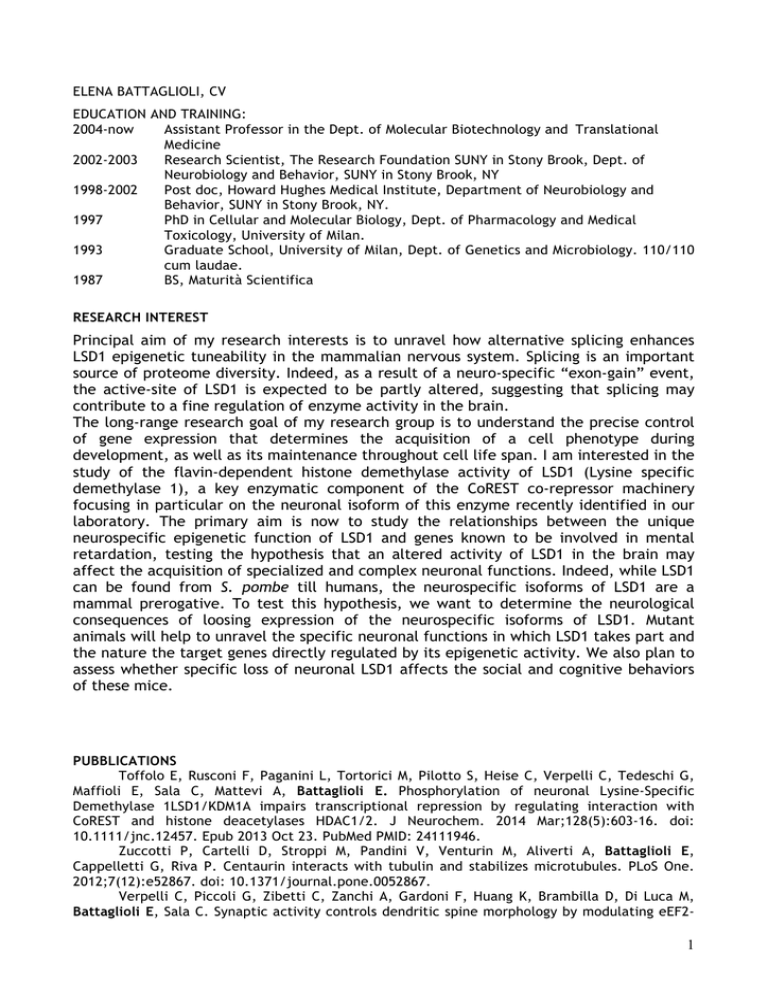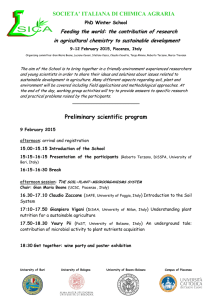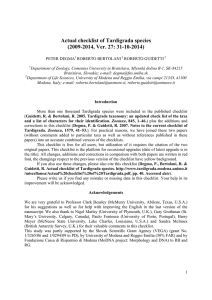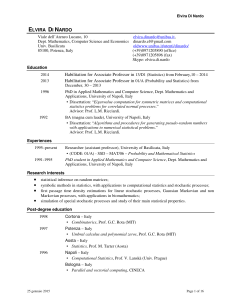PORTA ATTREZZI RADIOCOMANDATO RoboPOWER
advertisement

ELENA BATTAGLIOLI, CV EDUCATION AND TRAINING: 2004-now Assistant Professor in the Dept. of Molecular Biotechnology and Translational Medicine 2002-2003 Research Scientist, The Research Foundation SUNY in Stony Brook, Dept. of Neurobiology and Behavior, SUNY in Stony Brook, NY 1998-2002 Post doc, Howard Hughes Medical Institute, Department of Neurobiology and Behavior, SUNY in Stony Brook, NY. 1997 PhD in Cellular and Molecular Biology, Dept. of Pharmacology and Medical Toxicology, University of Milan. 1993 Graduate School, University of Milan, Dept. of Genetics and Microbiology. 110/110 cum laudae. 1987 BS, Maturità Scientifica RESEARCH INTEREST Principal aim of my research interests is to unravel how alternative splicing enhances LSD1 epigenetic tuneability in the mammalian nervous system. Splicing is an important source of proteome diversity. Indeed, as a result of a neuro-specific “exon-gain” event, the active-site of LSD1 is expected to be partly altered, suggesting that splicing may contribute to a fine regulation of enzyme activity in the brain. The long-range research goal of my research group is to understand the precise control of gene expression that determines the acquisition of a cell phenotype during development, as well as its maintenance throughout cell life span. I am interested in the study of the flavin-dependent histone demethylase activity of LSD1 (Lysine specific demethylase 1), a key enzymatic component of the CoREST co-repressor machinery focusing in particular on the neuronal isoform of this enzyme recently identified in our laboratory. The primary aim is now to study the relationships between the unique neurospecific epigenetic function of LSD1 and genes known to be involved in mental retardation, testing the hypothesis that an altered activity of LSD1 in the brain may affect the acquisition of specialized and complex neuronal functions. Indeed, while LSD1 can be found from S. pombe till humans, the neurospecific isoforms of LSD1 are a mammal prerogative. To test this hypothesis, we want to determine the neurological consequences of loosing expression of the neurospecific isoforms of LSD1. Mutant animals will help to unravel the specific neuronal functions in which LSD1 takes part and the nature the target genes directly regulated by its epigenetic activity. We also plan to assess whether specific loss of neuronal LSD1 affects the social and cognitive behaviors of these mice. PUBBLICATIONS Toffolo E, Rusconi F, Paganini L, Tortorici M, Pilotto S, Heise C, Verpelli C, Tedeschi G, Maffioli E, Sala C, Mattevi A, Battaglioli E. Phosphorylation of neuronal Lysine-Specific Demethylase 1LSD1/KDM1A impairs transcriptional repression by regulating interaction with CoREST and histone deacetylases HDAC1/2. J Neurochem. 2014 Mar;128(5):603-16. doi: 10.1111/jnc.12457. Epub 2013 Oct 23. PubMed PMID: 24111946. Zuccotti P, Cartelli D, Stroppi M, Pandini V, Venturin M, Aliverti A, Battaglioli E, Cappelletti G, Riva P. Centaurin interacts with tubulin and stabilizes microtubules. PLoS One. 2012;7(12):e52867. doi: 10.1371/journal.pone.0052867. Verpelli C, Piccoli G, Zibetti C, Zanchi A, Gardoni F, Huang K, Brambilla D, Di Luca M, Battaglioli E, Sala C. Synaptic activity controls dendritic spine morphology by modulating eEF2- 1 dependent BDNF synthesis. J Neurosci. 2010 Apr 28;30(17):5830-42. C. Zibetti, A. Adamo, C. Binda, F. Forneris, E. Toffolo, C. Verpelli, E. Girelli, A. Mattevi, C. Sala and E. Battaglioli. Alternative Splicing of the Histone Demethylase LSD1/KDM1 contributes to the Modulation of Neurite Morphogenesis in the Mammalian Nervous System. J Neurosci. 2010 Feb 17;30(7):2521-32. B. Bodega, G.D. Ramirez, F. Grasser, S. Cheli, S. Brunelli, M. Mora, R. Meneveri, A. Marozzi, S. Mueller, E. Battaglioli, E. Ginelli. “Remodeling of the chromatin structure of the facioscapulohumeral muscular dystrophy (FSHD) locus and upregulation of FSHD-related gene 1 (FRG1) expression during human myogenic differentiation”. BMC Biol. 7:41, 2009. F. Forneris, E. Battaglioli, A. Mattevi, C. Binda. New roles of flavoproteins in molecular cell biology: histone demethylase LSD1 and chromatin. FEBS J. 276:4304-4312. Review, 2009. A. Karytinos, F. Forneris, A. Profumo, G. Ciossani, E. Battaglioli, C. Binda and A. Mattevi “A novel mammalian flavin-dependent histone demethylase”. J Biol Chem. 2009 F. Forneris, C. Binda, E. Battaglioli and A. Mattevi. “Lsd1: Oxidative chemistry for multifaceted functions in chromatin regulation”. Trends Biochem Sci. 33:181-9, 2008. A. Gómez, J.C. Maass, E. Battaglioli, M. Kukuljan and M. Andres “CoREST represses the heat shock response mediated by HSF1”. Mol. Cell. ;31:222-31, 2008. F. Forneris, C. Binda, M.A. A. Adamo, E. Battaglioli and A. Mattevi. “Structural basis of LSD1-CoREST selectivity in histone H3 recognition”. J Biol Chem. 2007. B. Bodega, M.F. Cardone, S. Mueller, M. Neusser, F. Orzan, E. Rossi, E. Battaglioli, A. Marozzi, P. Riva, M. Rocchi, R. Meneveri and E. Ginelli “The human 4q subtelomere (4q35.2) has acquired a novel functional significance through evolutionary genomic remodeling” submitted to BMC Evolutionary Biology,14: 7-39, 2007 . F. Forneris, C. Binda, M.A. A. Dall’Aglio, E. Battaglioli and A. Mattevi. “A highly specific mechanism of histone H3-K4 recognition by histone demethylase LSD1”. J Biol Chem. 281(46):37289-95., 2006. F. Forneris, C. Binda, M.A. Vanoni, A. Mattevi and E. Battaglioli. “Demethylation pathways for histone methyllysine residues”. 24th Volume of “The Enzymes”(Elsevier/ Academic Press) 229-242, 2006. F Forneris, C Binda, MA Vanoni, E. Battaglioli and A. Mattevi. “Human histone demethylase LSD1 reads the histone code”. J Biol Chem. 280(50):41360-41365, 2005. F. Cargnin, A. Flora, S. Di Lascio, E. Battaglioli, R. Longhi, F. Clementi and D. Fornasari “Phox2b regulates its own expression by a transcriptional auto-regulatory mechanism”. J Biol Chem. 280(45):37439-48., 2005. F. Forneris, C. Binda, M. A. Vanoni, A. Mattevi and E. Battaglioli. “Histone Demethylation Catalysed by LSD1 is a Flavin-dependent Oxidative Process”, FEBS letters, 579(10):2203-7, (2005). E. Battaglioli, M.E. Andres, M.E. Anderson, D.W. Rose, M.G. Rosenfeld and G. Mandel. “REST repression of neuronal gene requires components of the hSWI/SNF complex”, J. Biol. Chem. 277(43):41038-41045, (2002). N. Ballas#, E. Battaglioli#, F. Atouf, M.E. Andres, J. Chenoweth, M. Anderson, C. Burger, M. Moniwa, J. Davie, W.J. Bowers, H.J. Federoff, D.W. Rose, M.G. Rosenfeld, P. Brehm and G. Mandel. “Regulation of Neuronal Traits by a Novel Transcriptional Complex”, Neuron, 3. 353-365 (2001). # Equal contribution Flora, R. Shulz, R. Benfante, E. Battaglioli, S. Terzano, F. Clementi and D.Fornasari. “Neuronal and Extra-Neuronal Expression and Regulation of the Human alpha5 Nicotinic Receptor Subunit Gene” J Neurochem.; 75(1):18-27 (2000). Flora, R. Shulz, R. Benfante, E. Battaglioli, S. Terzano, F. Clementi and D.Fornasari. “Neuronal and Extra-Neuronal Expression of the Human alpha5 Nicotinic Receptor Subunit Gene” Eur J Pharmacol., 393(1-3):85-95 (2000). J. A. Grimes, S. Nielsen, E. Battaglioli, A. Miska, J. Speh, D.L. Berry, F. Atouf, B.C. Holdener, G. Mandel and T. Kouzarides. “The Co-Repressor mSin3A is a Component of the RESTCoREST Repressor Complex”, The Journal of Biological Chemistry, 275. 9461-9467 (2000) M. E. Andres, C. Burger, M.J. Peral-Rubio, E. Battaglioli, M. Anderson, J. Grimes, J. Dallman, N. Ballas and G, Mandel. “CoREST: a Functional Co-Repressor Required for Regulation 2 of Neural-Specific Gene Expression” Proc. Nat.Acad. Sci. USA , 96. 9873-9878 (1999). E. Battaglioli, C. Gotti, S.Terzano, A.Flora, F. Clementi and D. Fornasari: "Expression and Transcriptional Regulation of the Human alpha3 Neuronal Nicotinic Subunit in T-Lymphocyte Cell Lines”. Journal of Neurochemistry, 71. 1261-1270 (1998). D. Fornasari, E. Battaglioli, S. Terzano, F. Clementi "Transcriptional Regulation of Neuronal Nicotinic Receptor Subunit Genes". In Neuronal Nicotinic Receptors: Pharmacology and Therapeutic Opportunities". Arneric and Brioni Eds. Wiley-Liss, NY (1997). E. Battaglioli "Caratterizzazione Strutturale e Funzionale del Promotore del Gene della Subunità alpha3 del Recettore Nicotinico Neuronale Umano. PhD Thesis, University of Milan (1997). D. Fornasari, E. Battaglioli, A. Flora, S. Terzano, F. Clementi "Structural and Functional Characterization of the Human alpha3 Nicotinic Subunit Gene Promoter" Molecular Pharmacology, 51: 250-261 (1997). 3


